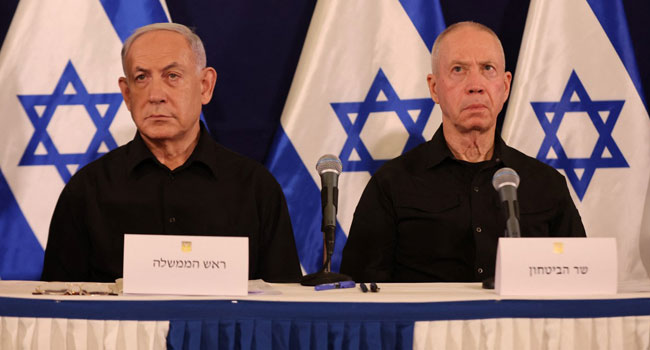The ceasefire, set to begin Sunday, would halt fighting and bombardment in Gaza's deadliest-ever war.
Israel’s cabinet has officially approved a ceasefire agreement in Gaza along with a hostage release deal, bringing an end to days of uncertainty regarding whether the truce would take effect over the weekend, according to Prime Minister Benjamin Netanyahu’s office.
The ceasefire, set to commence on Sunday, will temporarily halt the ongoing hostilities in what has been Gaza’s deadliest conflict. Additionally, the agreement includes the release of hostages held by Hamas since the October 7, 2023, attack on Israel, in exchange for hundreds of Palestinian prisoners detained in Israeli jails.
“The government has approved the plan for the return of hostages,” Netanyahu’s office confirmed early Saturday after the cabinet vote.
Israel’s justice ministry stated that as part of the initial phase, 737 prisoners and detainees would be released, though none before 4:00 pm local time (1400 GMT) on Sunday.
Despite the agreement, Israeli airstrikes continued, with the military reporting that approximately 50 targets across Gaza were hit in the past 24 hours.
The truce is set to begin just before the inauguration of Donald Trump, who has claimed credit for collaborating with outgoing U.S. President Joe Biden’s administration to secure the deal.
Israel’s security cabinet had previously approved the agreement, with Netanyahu’s office stating that it aligns with the overall war objectives.
Palestinian Authority President Mahmoud Abbas confirmed that preparations were in place for his administration to assume governance in Gaza after the conflict.
Meanwhile, displaced residents in Gaza are preparing to return home. “I just want to go back and kiss my land,” said Nasr al-Gharabli, who had fled his home in Gaza City. “Even if I die there, it is better than living as a displaced person.”
In Israel, the joy of the deal was tempered by sorrow for those still in captivity, including Kfir Bibas, the youngest hostage, who turned two on Saturday. Hamas had previously claimed in November 2023 that Kfir, his four-year-old brother Ariel, and their mother, Shiri, were killed in an airstrike. However, without confirmation from the Israeli military, many continue to hold onto hope.
“I think about them—the two little red-haired boys—and I get chills,” said 70-year-old Osnat Nyska, whose grandchildren attended the same nursery as the Bibas brothers.
Opposition and International Reactions
Two far-right ministers had opposed the deal, with one threatening to resign. However, U.S. Secretary of State Antony Blinken expressed confidence that the ceasefire would move forward.
“I am confident that implementation will begin as planned on Sunday,” Blinken stated.
Gaza’s civil defense agency reported that Israeli airstrikes had killed over 100 people and wounded hundreds more since the ceasefire deal was announced.
Hamas’s military wing, the Ezzedine al-Qassam Brigades, warned that ongoing Israeli strikes could jeopardize the hostages’ lives, turning their expected release into tragedy.
The October 7, 2023, attack by Hamas resulted in the deaths of 1,210 people, mostly civilians, according to Israeli official figures. Of the 251 hostages taken, 94 remain in Gaza, with 34 presumed dead, according to Israeli military reports.
In response, Israel’s military campaign has devastated much of Gaza, with 46,876 reported fatalities—mostly civilians—according to figures from the Hamas-run health ministry, which the UN considers credible.
Diplomatic Efforts and Future Prospects
The ceasefire deal emerged after intense mediation efforts by Qatar, the United States, and Egypt, following months of stalled negotiations.
During the final days of talks, Biden’s envoy Brett McGurk was joined by Trump’s representative, Steve Witkoff, in a rare bipartisan push to finalize the agreement.
“If we hadn’t been involved, this deal would never have happened,” Trump claimed in a Thursday interview.
Qatar’s Prime Minister, Sheikh Mohammed bin Abdulrahman Al-Thani, who announced the agreement, stated that the initial 42-day truce would involve the release of 33 hostages.
On Friday, he emphasized the goal of fully implementing the first phase and securing a resolution for the second phase. “We await a binding resolution from the UN Security Council to enforce the agreement,” he added.
While Israel assumes the 33 hostages are alive, Hamas has yet to confirm their status.
As part of the first phase, Israeli forces will withdraw from Gaza’s most densely populated areas, allowing displaced Palestinians to return home, according to the Qatari prime minister.
Sources close to Hamas informed AFP that three Israeli female soldiers—possibly civilians—would be the first hostages released on Sunday evening.
An Israeli military official confirmed that reception centers had been set up at Kerem Shalom, Erez, and Reim, where hostages would receive medical and psychological support before being transported to hospitals in Israel.
Israel is also expected to release Palestinian prisoners, including several serving long sentences.
Meanwhile, negotiators agreed on Friday to establish a joint operations center in Cairo to oversee the ceasefire’s implementation and compliance, according to Egyptian state-linked media.
French President Emmanuel Macron confirmed that French-Israeli citizens Ofer Kalderon and Ohad Yahalomi were among those slated for release in the first phase.
President Biden suggested that the second phase of the deal could lead to a “permanent end to the war.”
However, in Gaza—where nearly all of the 2.4 million residents have been displaced at least once—humanitarian workers warn of an immense recovery challenge.
“Everything is in ruins, children are living on the streets—it’s impossible to prioritize just one issue,” said Amande Bazerolle, a coordinator for Doctors Without Borders.


No comments:
Post a Comment